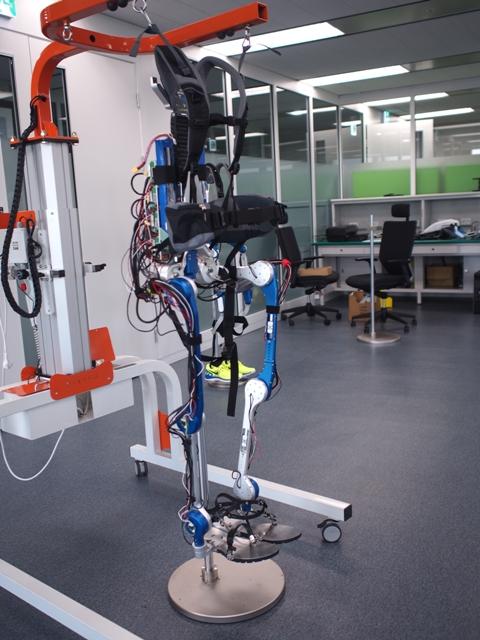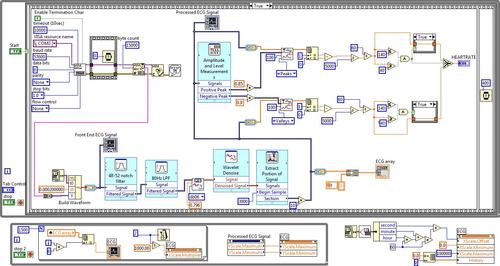Hyundai Demos Robotic Exoskeleton at NIWeek 2015
Automaker Hyundai presented a robotic exoskeleton assistive walking device at NIWeek 2015.
August 18, 2015
In one of the latest examples of mechatronics implementation into medtech, research engineers from Hyundai Motor Group's Central Advanced Research and Engineering Institute in South Korea presented a robotic exoskeleton assistive device at the recent NIWeek conference hosted by National Instruments (NI) in Austin, Tex.
The Life-Caring Exoskeleton was built to provide walking assistance for the disabled or elderly and is powered by a lithium-ion battery housed in a compact backpack.

Hyundai's Life-Caring exosuit offers walking assistance with a full spectrum of mobility. (Source: National Instruments)
Senior research engineer DongJin Hyun demonstrated the unit during a keynote presentation at the NI event. Jeffrey Phillips, section manager for software platforms at NI, told Design News that the product is in the prototype stage and not yet commercial.
Developing a product like this is anything but simple and straightforward. To provide mobility assistance to a human wearer, the suit has to be able to sense the user's intention and provide just the right amount of power at the right vector, thus requiring complex control algorithms operating in real time to coordinate multiple sensors and actuators. Such a device is also mandated to be lightweight and compact, so the user can easily put it on and move around in it.
To get to the current functional robot, engineers had to run through a number of steps and changes in the prototyping process to get the device down to a reasonable size and weight of less than 10 kg. Sensors and electronic communication methods changed over the course of prototype iterations, pushing changes in the control architecture.
MORE FROM DESIGN NEWS: Highlights of National Instruments' NIWeek 2015 (Slideshow)
Lightweighting was especially important when it came to the key piece of onboard hardware: the robotic controller. In the early stages, Hyundai engineers employed NI's CompactRIO cRIO-9082 and cRIO-9033 robotic controllers. These were too heavy and power-hungry for a wearable device, so the team switched to the lighter sbRIO-9651 system-on-module (SOM), a small circuit board with an aluminum case. The 9082 weighs in at a hefty 3.1 kg and the 9033 at 1.8 kg. The 9651, though, weighs only 100 grams but rugged enough and capable of withstanding movement, stress, and outdoor rigors.
The Hyundai team used NI's LabVIEW software in conjunction with the RIO hardware. One of LabVIEW's selling points is its suitability for this kind of agile mechatronics development environment, where the design can change rapidly along multiple axes. In a paper for NI, DongJin explained that complex robotic devices can comprise a large number of sensors and actuators assigned to perform complex tasks. As the numbers of devices and tasks increase, "the complexity of the control algorithms increases exponentially," he said. This means that “simultaneously processing all data from multiple sensors and sending instructions to multiple actuators becomes one of the most important challenges to address in robotics.”
In an announcement from NI, DongJin commented that LabVIEW and the RIO architecture allowed his team to “reduce the time of developing and testing a new robot control algorithm” and “to prototype with software and hardware faster and adapt to rapidly changing control requirements.”

The LabVIEW interface. (Source: National Instruments)
This is attributed to the graphical programming environment employed in LabVIEW, explained NI's Phillips. “Common lower-level programming languages like C or C++ are text-based,” he told Design News. As a visually-based development environment, LabVIEW is quicker to use and more intuitive.
Does that mean it's dumbed-down, though? No, Phillips stressed: “LabVIEW doesn't lack any of the capability or programming concepts of text-based programming languages, but we believe it enables programmers to write code faster.”

We’re heading to Philly! Design & Manufacturing Philadelphia will take place Oct. 7-8. Get up close with the latest design and manufacturing technologies, meet qualified suppliers for your applications, and expand your network. Learn from experts at educational conferences and specialty events. Register today and join us at Philadelphia’s premier industry showcase!
Al Bredenberg is a writer, analyst, consultant, and communicator. He writes about technology, design, innovation, management, and sustainable business, and specializes in investigating and explaining complex topics. He holds a master's degree in organization and management from Antioch University New England. He has served as an editor for print and online content and currently serves as senior analyst at the Institute for Innovation in Large Organizations.
You May Also Like

.jpg?width=300&auto=webp&quality=80&disable=upscale)

